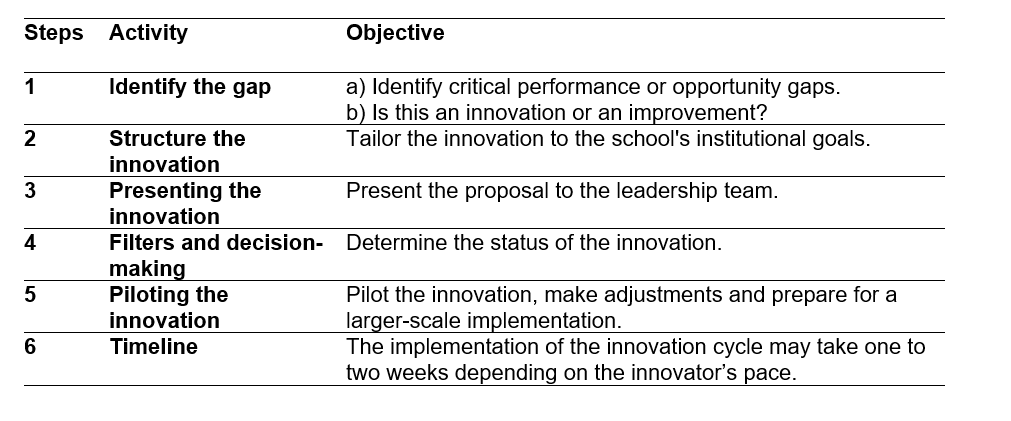By Anabella Martinez and Kenneth Steenhuisen
Innovation plays a crucial role in driving excellence and continuous growth in schools. While educators agree on the importance of building a culture of innovation that fosters creativity and agency in their professional community, teachers and administrative staff face different challenges in transforming an idea into a feasible project. This article shares strategies to foster a culture of innovation where teachers feel encouraged and supported to materialise their ideas.
What is innovation?
Differentiating between improvement and innovation is important. Improvement refers to minor adjustments to increase efficiency or eliminate identified deficiencies in current institutional processes. Innovation is defined as ‘Employing a tool, approach, or project that is new to the school or that fundamentally changes current institutional processes (teaching and learning), leading to new capabilities and accelerated improvement’ (Harvard, sf). When a teacher suggests an idea with the potential for innovation, it becomes imperative to establish a path for its implementation.
Anticipating potential challenges
Schools face challenges when trying to foster innovation among their teachers. Identifying these challenges is important to determine strategies to counteract them. They may include hidden innovation, structural inertia and cultural inertia (Harvard, sf). ‘Hidden innovations’ are opportunities for innovation that are not prioritised. ‘Structural inertia’ is the resistance to change due to size, complexity and interdependence in an organisation’s structure. ‘Cultural inertia’ manifests as a tendency to uphold long-standing traditions and processes. Taking into account these challenges, we share below institutional conditions to support feasible innovations at schools.
While educators agree on the importance of building a culture of innovation that fosters creativity and agency in their professional community, teachers and administrative staff face different challenges in transforming an idea into a feasible project.
1. Establish an innovation team
To ensure that ideas can flourish, it is important to have an innovation team that is approachable for teachers to share their ideas. This team must support and guide teachers to materialise their ideas and provide an initial analysis of alignment with institutional priorities and feasibility. This team should be constituted by teachers and academic-administrative staff.
2. Define the path to materialise innovation
The next condition to support teachers in innovating to bolster teaching and learning at the school is to establish a clear process and connect teachers with school leadership. Below you will find the steps suggested for this process.
Table 1
 Table 1: Steps of the Innovation Model (Harvard Business School, 2012).
Table 1: Steps of the Innovation Model (Harvard Business School, 2012).
These steps ensure that innovations are proposed within the context of institutional needs, aligned with priorities, and an analysis of factors that can hinder or promote it. The possibility of piloting the innovation facilitates the identification of gaps in practice.
3. Define the filter with the ‘funnel of innovation’
Creating a step-by-step process like the ‘funnel of innovation’ (Rey, 2017) serves to filter proposals by prompting the innovation team to ponder questions regarding alignment, applicability and impact. The filter has two categories: guiding statements, and relevance and capacity. The first filter focuses on stimulating reflection on the alignment of the innovation with institutional vision and priorities, and the second on exploring the feasibility of implementation by identifying available resources for deployment. Table 2 provides some questions to address these filters.
Table 2

Table 2: Questions from the funnel of innovation
4. Analysis and decision-making
Reflection and analysis from the funnel are consolidated through its filters. These questions use a Likert scale with points assigned per option (1. totally disagree; 3. somewhat agree; 5. totally agree). The results are analysed with the innovation benchmark and an innovation matrix where the results are classified as basic innovation, disruptive innovation, breakthrough innovation or sustained innovation as shown in Table 3.
Table 3

Table 3: Innovation Matrix (Satell, 2017; Janse, 2019).
The innovation matrix helps to interpret the results and highlight the strengths and possible risks of the innovation given the level of alignment it indicates, being low or high. This information can then be used by the school’s leadership team to decide on the innovation. The first step of the implementation of the innovation is a pilot with one specific target area. The school will monitor this pilot providing the tools needed to successfully develop the innovation. The school will make the adjustments needed for a large-scale implementation (Nieminem, 2020).
Successful innovation: Youtorials
Marymount Barranquilla implemented the model of innovation resulting in the Youtorials project. It was shared with staff through workshops, prompting the presentation of different proposals. Second-grade co-teachers proposed an innovative way of teaching technology through cross-curricular project-based learning. Based on students’ interest in becoming YouTubers, teachers created this project where our second-grade students created tutorials on topics they mastered throughout their academic year. After the co-teachers presented their proposal, they received feedback and made significant adjustments. For example, they included a rubric that was shared with the students to ensure complete clarity regarding learning expectations and success criteria. Additionally, they provided more resources for students to enhance their video-making skills. Students shared their knowledge, and co-teachers created a site where they uploaded their tutorials for first-grade students to use as study material when they reached second grade. This project was presented in the digital technology category and was named the winner at the International School Awards hosted by ISC Research.
This international recognition signifies the successful implementation of school-established conditions that support teachers in innovating and enhancing their skills to benefit students’ learning.
Recommendations
- Strategic team formation: when forming your innovation team, be strategic in ensuring the participation of academic-administrative staff who play a vital role in the decision-making process.
- Team composition: assemble an innovation team consisting of two to three members, including an academic-administrative staff member and one or two teachers who are approachable by their peers.
- Clear and concise feedback: when providing feedback on innovations, prioritise clarity and conciseness. It is essential for teachers to comprehend the reasons behind suggested adjustments and expectations.
- Effective monitoring: establish a robust monitoring system for your innovation once the pilot phase is underway. Timely feedback and intervention are pivotal in ensuring the success of the innovation in its early stages.
- Financial support for teachers: recognise that teachers may require financial support when structuring their innovations. Facilitate connections between teachers and members of the financial department to assist in designing the budget necessary for proposal implementation.


Anabella Martinez is School Director at Marymount School Barranquilla. Connect with Anabella on LinkedIn. Kenneth Steenhuisen is Academic Director at Marymount School Barranquilla. Connect with Kenneth on LinkedIn.





